NASA Extends Cyclone Global Navigation Satellite System Mission

NASA has awarded a contract to the University of Michigan for the Cyclone Global Navigation Satellite System (CYGNSS) for mission operations and closeout. A constellation of eight microsatellites, the system can view storms more frequently and in a way traditional satellites are unable to, increasing scientists’ ability to understand and predict hurricanes.
The total value of the contract is approximately $39 million. The CYGNSS Science Operations Center is located at the University of Michigan.

For decades, NASA has played a leading role in using Earth-observing satellites to collect the data required to feed numerical weather prediction models. CYGNSS continues that work, using a remote sensing technique called “GPS signal scattering” to see through heavy rain to estimate the strength of surface winds in the inner cores of hurricanes.
“CYGNSS has been a pioneering mission that has given us new insight into the dynamics of rapidly intensifying tropical cyclones,” said Karen St. Germain, director of NASA’s Earth Science Division. “CYGNSS is also a powerful tool for flood detection on land and ocean microplastic debris detection – that’s the kind of added value we love to see, and it’s paving the way for more science that will have significant societal benefits.”
The measurements from CYGNSS are useful for research in algorithm development, analysis to assist with future modeling efforts, and Earth system process studies.
Further operations will enable new research looking at long-term climate variability and increase the sample size of extreme events that can assist with modeling and forecasting. CYGNSS satellites continue to take 24/7 measurements of ocean surface winds, both globally and in tropical cyclones, which can be used to study meteorological processes and improve numerical weather forecasts. On land, the satellites take continuous measurements of flood inundation and soil moisture that are used in hydrological process studies and for disaster monitoring.
For more information about the CYGNSS mission, visit:
For general NASA hurricane science reference material, visit:
https://www.nasa.gov/feature/goddard/2021/nasa-and-hurricanes-five-fast-facts
and
https://www.nasa.gov/mission_pages/hurricanes/news/index.html
-end-





